Coconut Chutney Recipe
Coconut Chutney recipe is a classic South Indian condiment made from freshly grated coconut blended with roasted chana dal, green chillies and ginger, tempered with whole spices, urad dal, curry leaves, dried red chilies and asafoetida, creating a creamy, flavorful accompaniment to traditional dishes like Idli, Dosa, Uttapam, Medu Vada and other South Indian delicacies. Learn how to make this essential Indian side dish with my easy-to-follow step-by-step photos and a video!
About Coconut Chutney
Chutneys are a class of condiments that originated in India and can be made from a multitude of different ingredients.
Just on this site, I have recipes for tomato, coriander, peanut, tamarind and onion chutneys, and that isn’t even my full list!
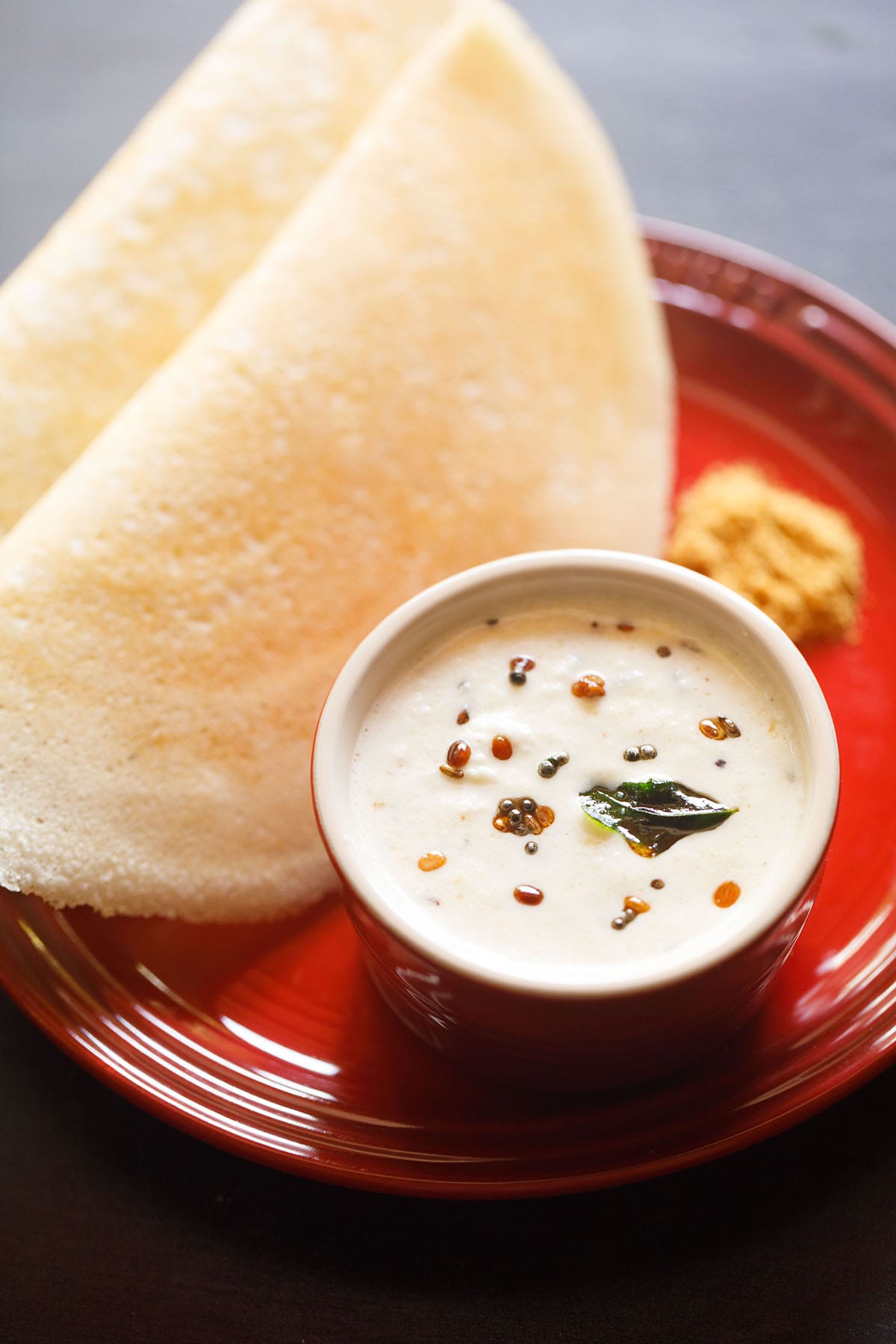
All of these delicious savory sauces and relishes are used to enhance the flavors of various meals.
Coconut Chutney originated from the South Indian cuisine. It is most often served with breakfast or snack dishes.
In its simplest form, it is made by finely grinding fresh white coconut meat with either green chilies or dry red chilies and salt added to it.
Chilies lend a bit of heat and spice in the chutney. Garlic or ginger can be added for more savory depth.
A tempering of oil with crackled mustard seeds, fried urad dal (black gram), crisp curry leaves and asafoetida (hing) brings more flavor to otherwise plain coconut chutney.
About My Recipe
I have been making this easy-peasy basic coconut chutney recipe for decades now, and it is still a favorite in our house.
As someone who cooks very often, the fact that this coconut chutney makes regular appearances on our table should indicate just how delicious it is!
Made in the Tamil Nadu style, this particular recipe calls for roasted chana dal to be added. Also known as chana daria, these husked and split black chickpeas have a lovely rich and nutty taste.
While roasted chana dal are readily available for purchase in India, I know that they are not available everywhere.
You can either opt to fry these lentils on your own at home, or simply skip it. Don’t worry, the coconut chutney will still be delicious without it.
If fresh coconut is not available to you, simply swap in frozen coconut or unsweetened dessicated coconut flakes instead. This easy recipe will work with whatever you have on hand.
You can also adjust the basic recipe by adding different ingredients. For example, if you add some roasted sesame seeds, dry red chilles and a touch of tamarind, it makes a lovely sauce for serving with steamed rice!
One of my favorite things about coconut chutney is how versatile it is! Apart from serving with breakfast foods like idli, dosa and vada, you can also serve it with tons of South Indian snacks.
We like to top it on Upma, Semiya Upma, Pongal and additionally serve it as a side dip with snacks like Mysore Bonda, Onion Pakoda and so many other dishes.
I have a feeling that once you try it, coconut chutney will become one of your favorite condiments, too. When paired with Idli Sambar, it is even more enticing.
My mom-in-law who is Punjabi absolutely LOVES South Indian food, and this coconut chutney is one of her favorites. If you, like her, love anything with coconut, then you’re sure to love this traditional coconut sauce.
How to make Coconut Chutney
Grind Ingredients
1. Add ½ cup tightly packed freshly grated coconut in a chutney grinder jar or a small grinder jar.
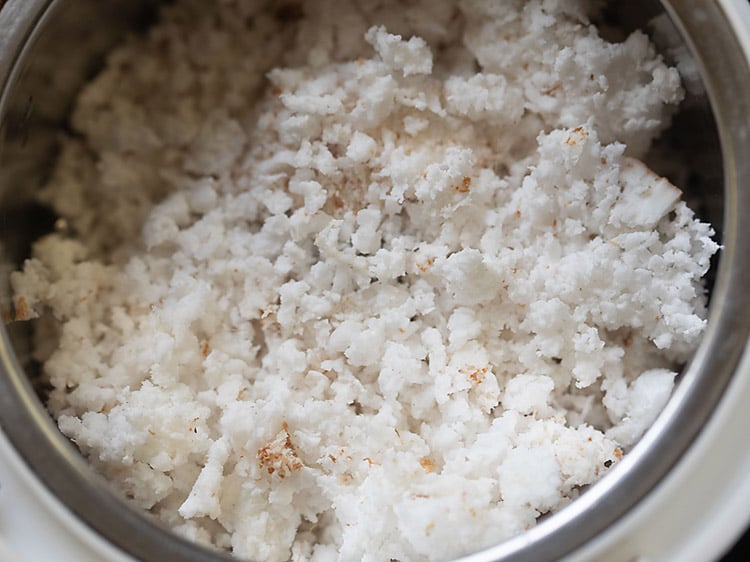
2. Add 1 to 2 chopped green chillies (depending on your heat preference), ½ inch chopped ginger (optional, can substitute with 2 small cloves of garlic) and 2 tablespoons roasted chana dal.
Note: 1 green chili will yield about ½ to 1 teaspoon of chopped chillies. I have used about ½ teaspoon of chopped green chillies. For a spicy coconut chutney, depending on the pungency of the chilies, consider to add 2 to 3 green chilies.
Tip: You can swap the Indian variety of green chillies with ½ teaspoon of Serrano or Anaheim peppers. If using Thai green chillies, add about ¼ teaspoon chopped as they are very spicy.
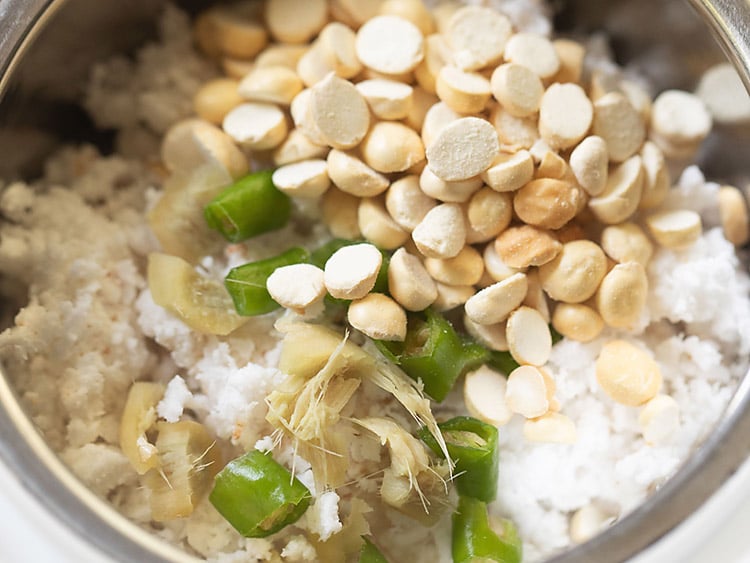
3. Add salt to taste. I suggest starting with less salt at first. Then, after grinding, check the taste and add some more salt if required.
Remember, you can always add MORE salt, but you can’t take it away once it has been added.
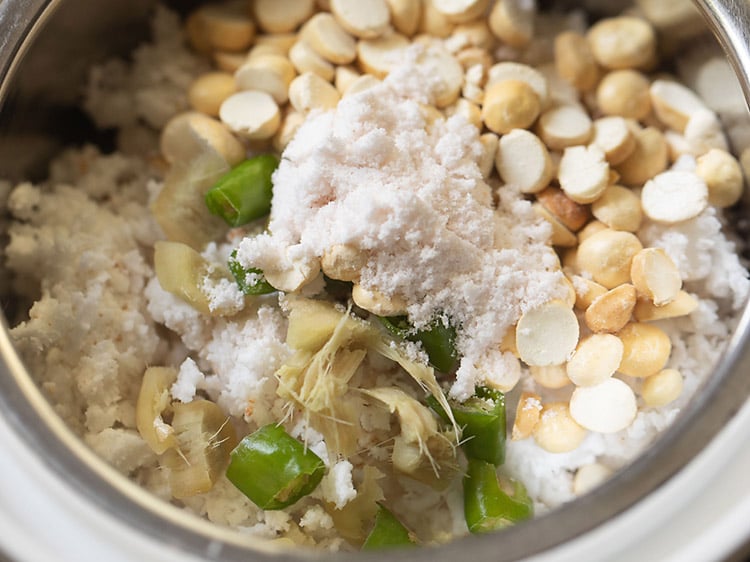
4. Add 3 to 4 tablespoons water. You can make this coconut chutney thicker by adding less water. You can skip roasted chana dal if you do not have it.
Note: Roasted chana dal is different from raw chana dal. Roasted chana dal is crunchy and directly edible, unlike raw chana dal.
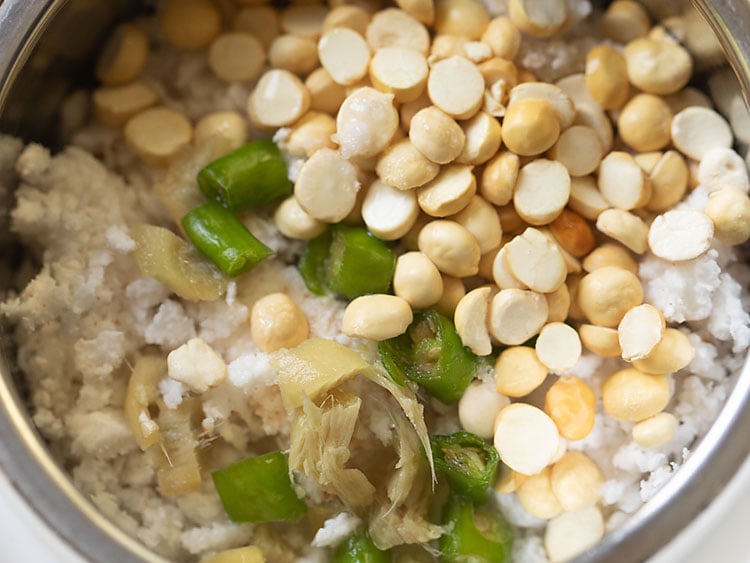
5. Grind to a fine and smooth consistency. If the blade is unable to grind or the chutney looks thick, then you can add 1 to 2 tablespoons more water or as needed.
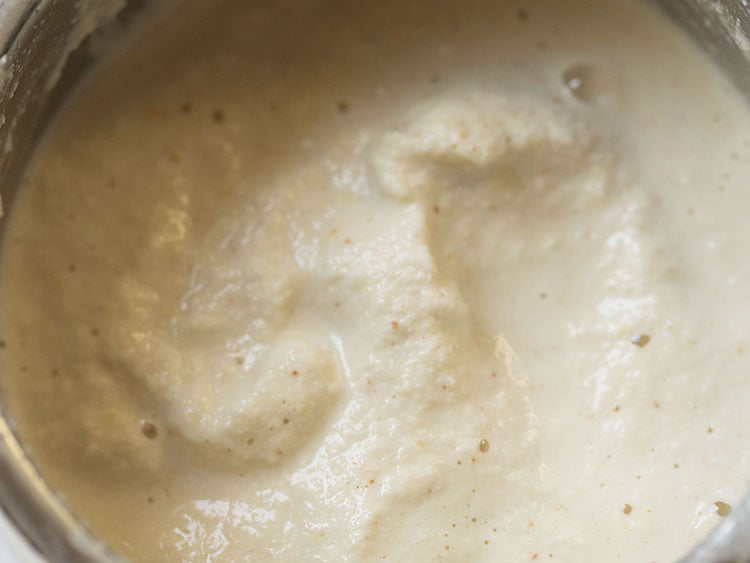
6. Remove the chutney with a spoon or spatula in a heat proof bowl (e.g. steel, pyrex or glass). Check the taste and add more salt if needed.
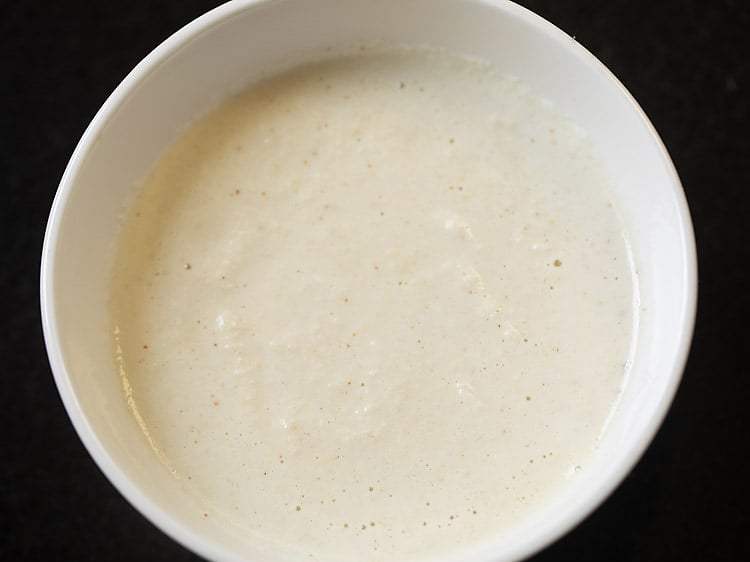
Temper & Make Coconut Chutney
7. In a small pan or a tadka pan, heat ½ tablespoon sesame oil (gingelly oil – made from raw sesame seeds) over low heat.
Note: You can also use sunflower oil, peanut oil, coconut oil or any neutral flavored oil.
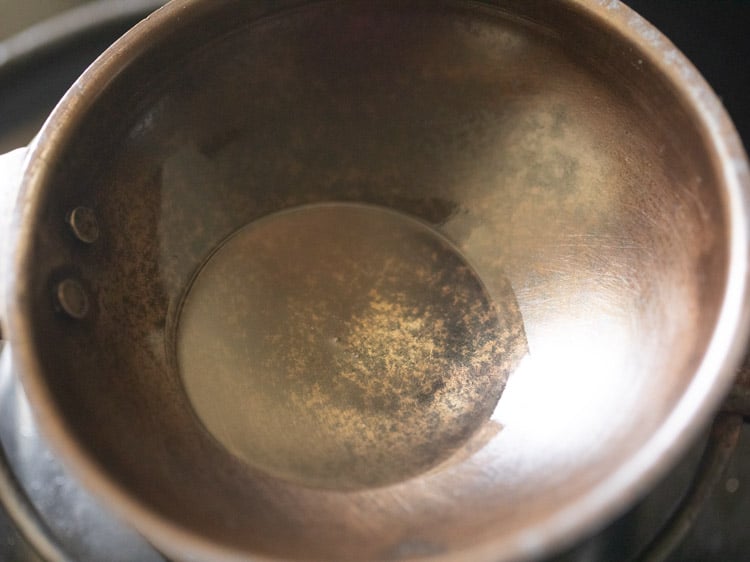
8. Add ½ teaspoon mustard seeds and let them begin to crackle.
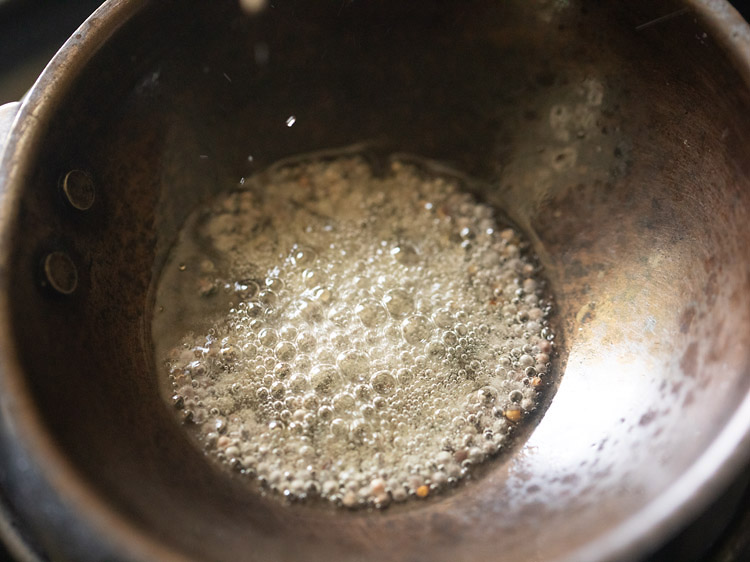
9. Once the mustard seeds begin to crackle, add ½ teaspoon urad dal (split and husked black gram).
Note: If you don’t have urad dal then feel free to skip in the recipe.
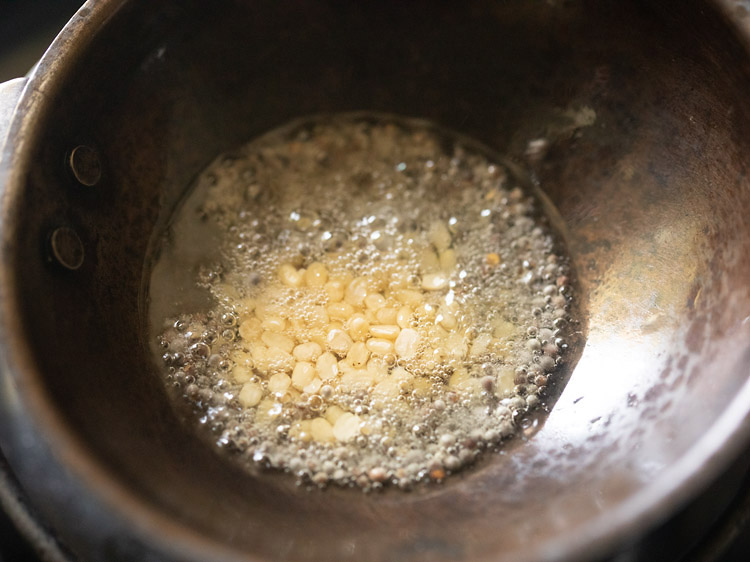
10. Next add ½ teaspoon cumin seeds. You can skip cumin seeds if you prefer.
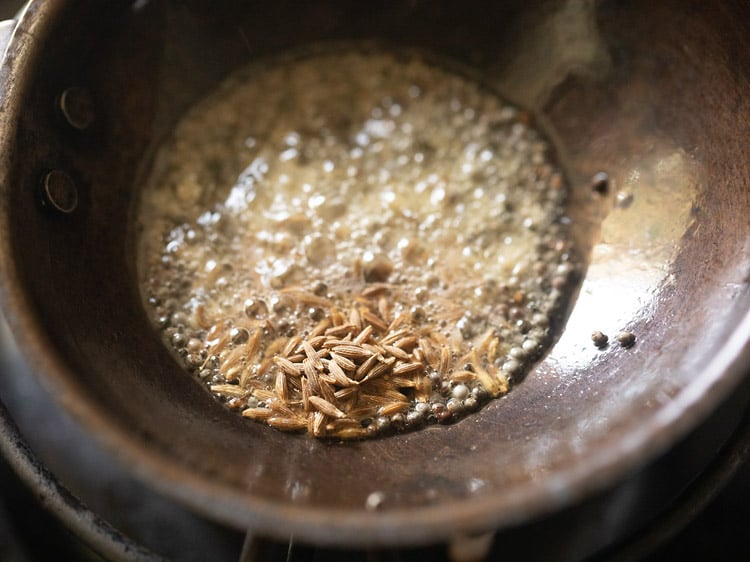
10. Stir often and fry keeping the flame to a low.
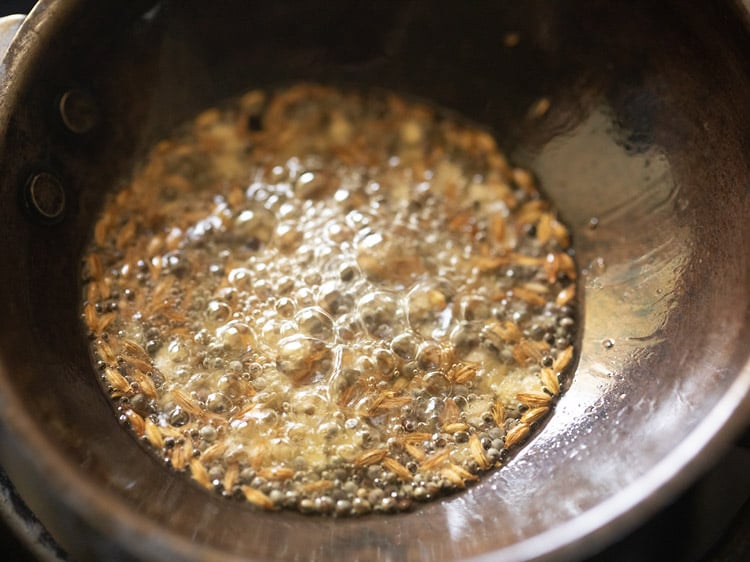
11. The urad dal should start becoming golden. The cumin seeds will also crackle and get browned.
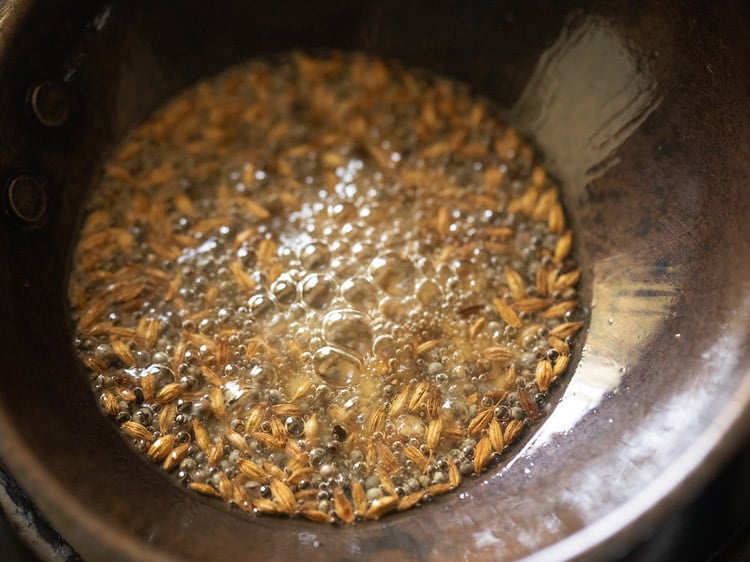
12. Once the urad dal begins to turn to a golden color, then add 1 dry red chilli (broken and seeds removed), 9 to 10 curry leaves and a pinch of asafoetida (hing).
If the pan becomes very hot, then switch off the flame after adding the red chili, curry leaves and asafoetida.
Be careful as after adding the curry leaves the oil splutters.
Note: If you are gluten free, please be sure to check that your asafoetida is gluten free as many commercially available varieties are processed with wheat products.
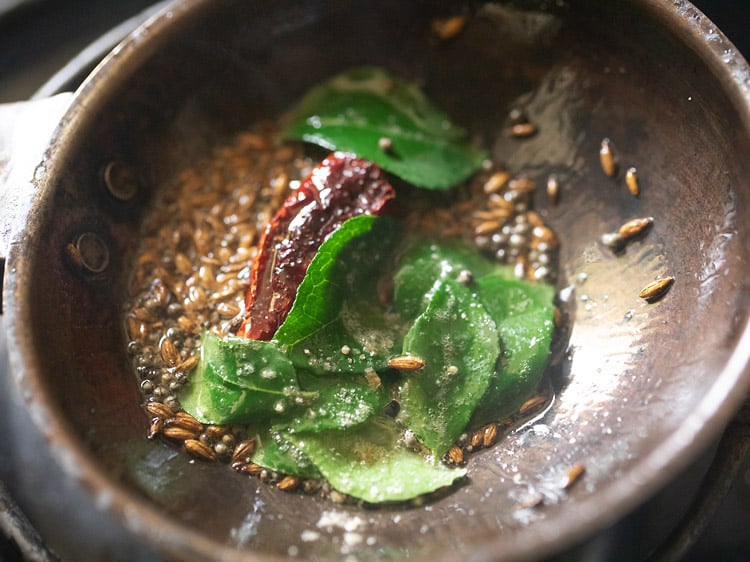
13. Stir and fry for a couple of seconds till the curry leaves become crisp and the red chilli changes color.
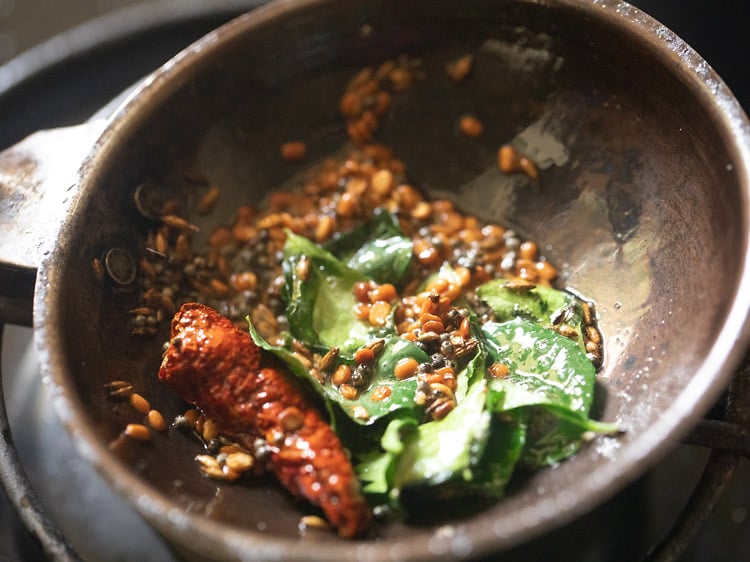
14. Switch off the flame and immediately pour the entire tempering together with the oil on the ground coconut chutney in the bowl.
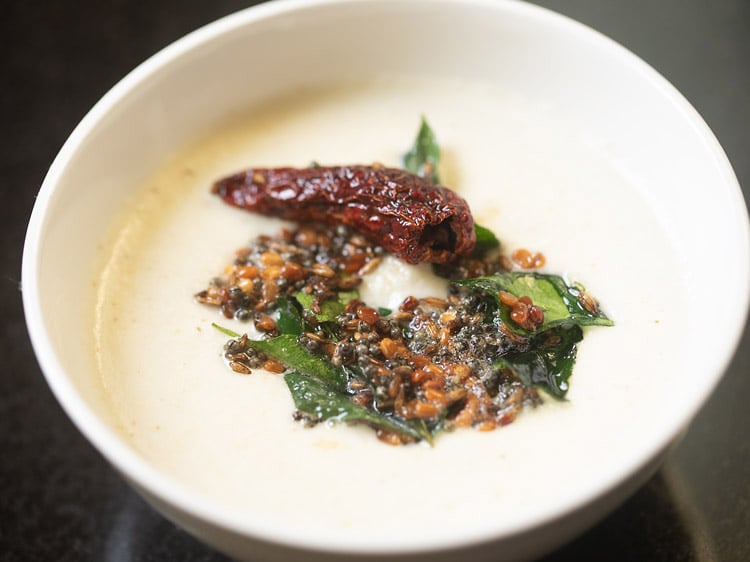
15. Mix very well.
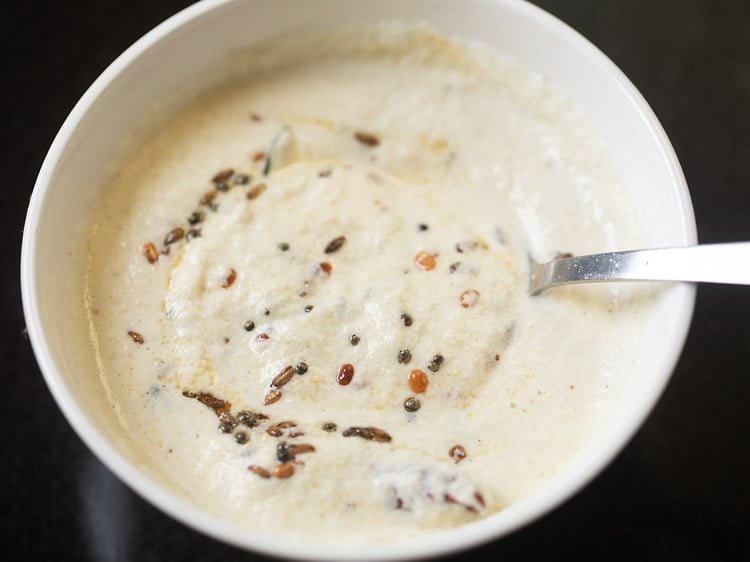
16. Serve Coconut Chutney with idli, dosa, vada, pongal or pakoda of your choice.
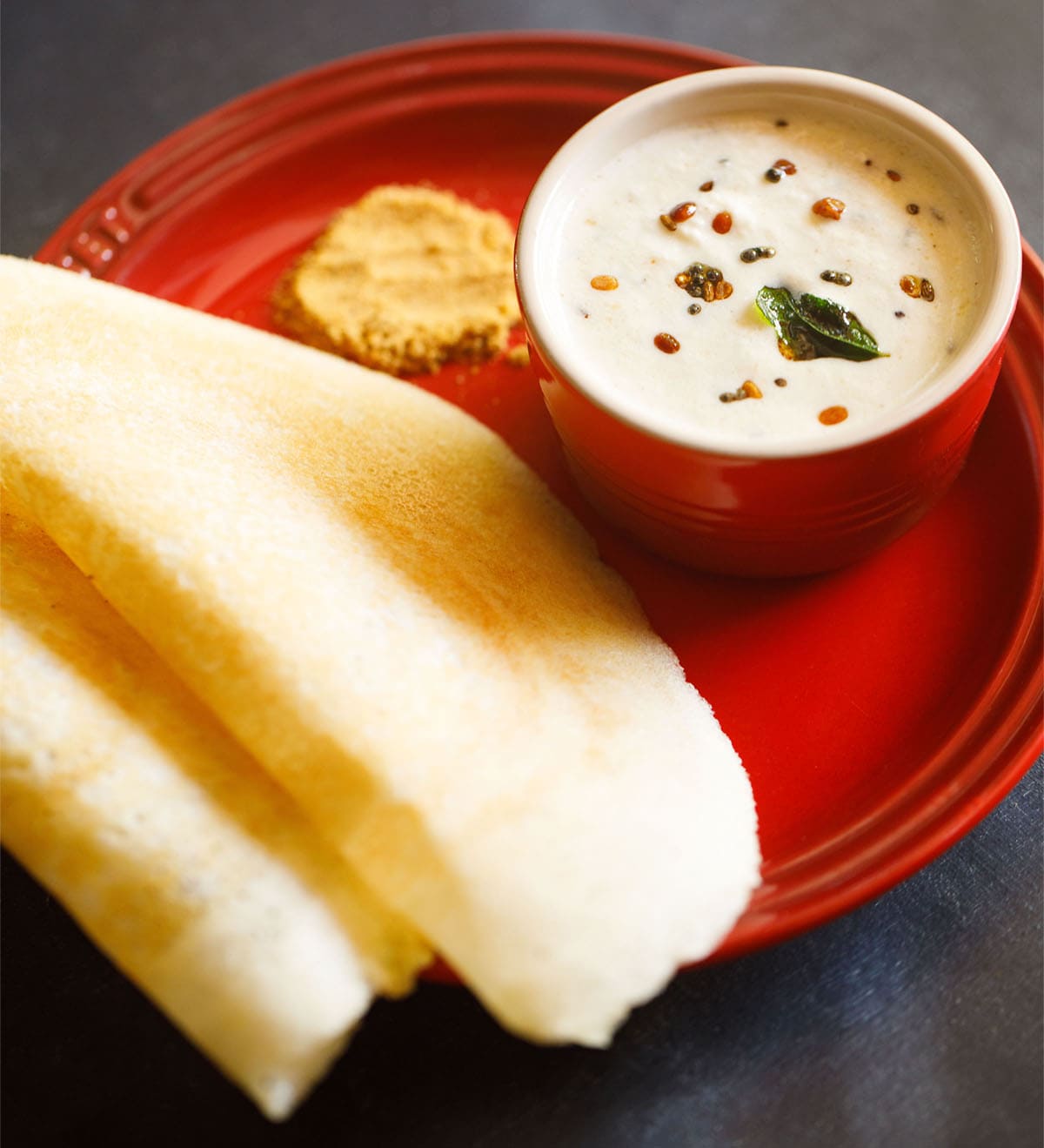
Variations
Myriad variations of coconut chutney can be made by adding extra ingredients like fresh mint leaves, coriander leaves, garlic, curd (yogurt), tamarind, tomatoes, onions, almonds, carrots, beetroot, unripe mangoes, peanuts, capsicum, and greens like spinach.
The ingredient(s) you add will change the flavor of the resulting coconut chutney – e.g. adding tamarind or tomatoes will impart a sour taste in the chutney, while adding fresh herbs like mint or coriander will add a bit of fresh, herb-y flavor to the final product.
I recommend that you experiment with different ideations of this delightful condiment because there are just so many to choose from! It is hard for me to pick my favorite.
Here are some of my most favorite coconut chutney recipes
Expert Tips
- For a tangier chutney: If you like a little sourness in your coconut chutney, you can add one or both of the following ingredients:
- Tamarind: Take about ½ to 1 teaspoon of tamarind and grind it with the rest of the ingredients.
- Curd (yogurt): When the chutney mixture is ground, then take it in a bowl. Mix it with 2 to 3 tablespoons fresh curd or yogurt. This has to be done before you temper the coconut chutney.
- Serve immediately: Coconut chutney has to be consumed fresh. Avoid keeping the chutney at room temperature for very long. If you have to keep it for a few hours, then keep it in the freezer section of your refrigerator and consume the coconut chutney within a day.
- Increasing shelf life: Adding tamarind to the chutney increases its shelf life a little more. You can freeze the chutney for up to 1 day if tamarind is added.
- Using desiccated coconut: If you are using desiccated coconut or coconut powder, use warm water while grinding the chutney to get the right consistency.
- Scaling: You can easily halve, double or triple the recipe per your needs.
FAQs
How do you eat chutney?
Chutney is basically a condiment used to enhance the flavors of different dishes. You can either dip your food into it, or drizzle or dollop it over your preferred dishes. This coconut chutney recipe is particularly good when paired with South Indian breakfast foods and snacks.
Can I make coconut chutney using frozen coconut?
Absolutely! If your coconut is already grated, there is no need to defrost it first. Also, please note that I recommend you use coconut that you have frozen for yourself, rather than opting for store bought packs.
Several readers have told me that the store-bought frozen coconut has separated for them when they go to grind it, resulting in a much different taste. To avoid this I recommend adding warm to slightly hot water while grinding the coconut.
You can also opt to use unsweetened desiccated coconut instead, which I have never had trouble with. Simply grind with warm water to get the right consistency in your coconut chutney recipe.
Can I use roasted husked kala channa instead of roasted channa dal?
Yes! You can also opt to omit the roasted channa dal if you do not have access.
Step by Step Photo Guide Above
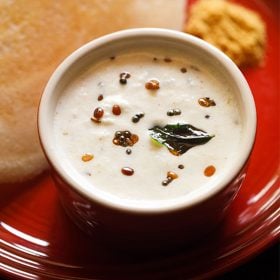
Coconut Chutney Recipe
Ingredients
for grinding
- ½ cup fresh grated coconut (tightly packed) or ½ cup desiccated coconut
- 2 tablespoons roasted chana dal – optional
- 1 or 2 green chilies or ½ teaspoon chopped green chillies or serrano or anaheim pepper
- ½ inch ginger – optional, you can also add 1 to 2 small garlic cloves
- salt as per taste
- 3 to 4 tablespoons water or add as required – for grinding
for tempering
- ½ teaspoon mustard seeds
- ½ teaspoon urad dal (split and husked black gram)
- ½ teaspoon cumin seeds – optional
- 9 to 10 curry leaves or 1 sprig of curry leaves
- 1 pinch asafoetida (hing)
- 1 dry red chili – broken and seeds removed
- ½ tablespoon oil – sesame or peanut or coconut or sunflower oil or any neutral oil
Instructions
Grinding Ingredients
- Take the freshly grated coconut in a chutney grinder jar or a small grinder jar.
- Then add the green chili and ginger.
- Next add the roasted chana dal. Also add salt as per taste. Add 3 to 4 tablespoons water.
- Grind to a smooth consistency. If unable to grind or the chutney looks thick, then you can add 1 to 2 tablespoons more water.
- Remove the chutney in a heatproof bowl like a steel bowl or a pyrex bowl.
Tempering
- Heat oil in a small pan. Add the mustard seeds.
- When the mustard seeds begin to splutter, add the cumin seeds and urad dal. Fry till the urad dal starts to become golden and aromatic.
- Then add the curry leaves, red chili and asafoetida.
- Fry for a couple of seconds till the curry leaves become crisp and the red chillies change color making sure that the curry leaves and chilies do not get burnt.
- Switch off the heat and immediately pour the tempering on the chutney in the bowl.
- Mix the tempering mixture very well.
- Serve coconut chutney with idli, dosa, vada, pongal or pakoda of your choice.
Video
Notes
- Scaling: This coconut chutney recipe can be halved or doubled or tripled.
- Spiciness: Add 2 to 3 green chillies for a spicy taste in the coconut chutney.
- Herbs: Instead of ginger, you can add garlic. Ginger can be skipped completely. You can even add some fresh coriander leaves (cilantro) or mint leaves.
- Dry Red Chillies: You can even add 2 to 3 dry Kashmiri red chillies or 1 to 2 dry red chillies and make a red coconut chutney. A bit of tamarind can be added if using dry red chillies to balance the pungency and heat of the chillies. Remove the seeds from the chillies before you grind them with the rest of the ingredients.
- To Make White Coconut Chutney:
- For a white coconut chutney, add less of the roasted chana dal or skip it entirely. So for this recipe add ½ tablespoon of roasted chana dal.
- Also add less green chillies or you can skip them.
- Do use only the white part of the coconut and not the brown part.
- You can even add some nut milk or thin coconut milk instead of water while grinding.
Nutrition
Coconut Chutney recipe from the archives was first published on April 2014.

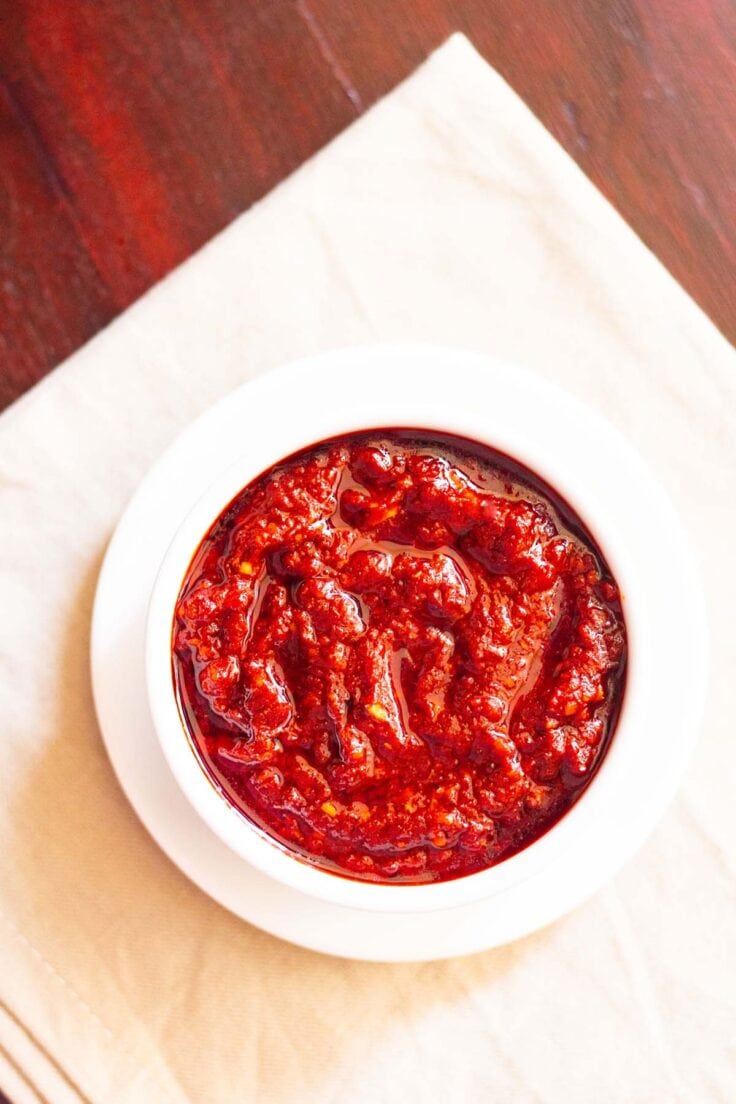
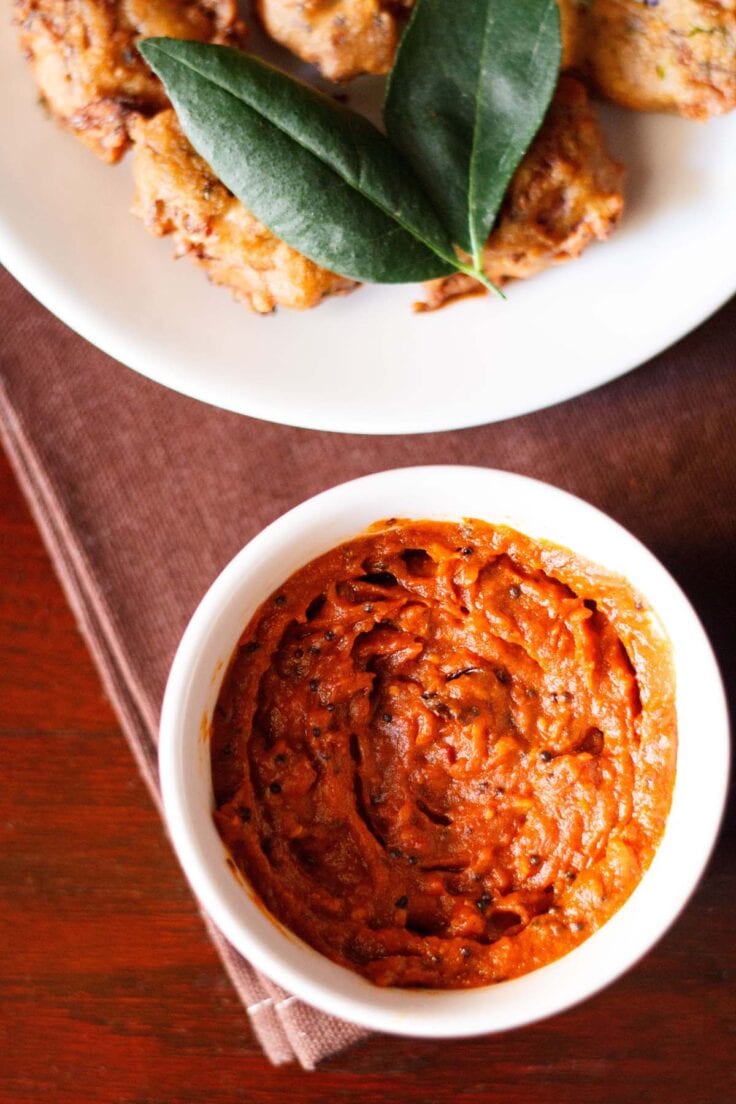
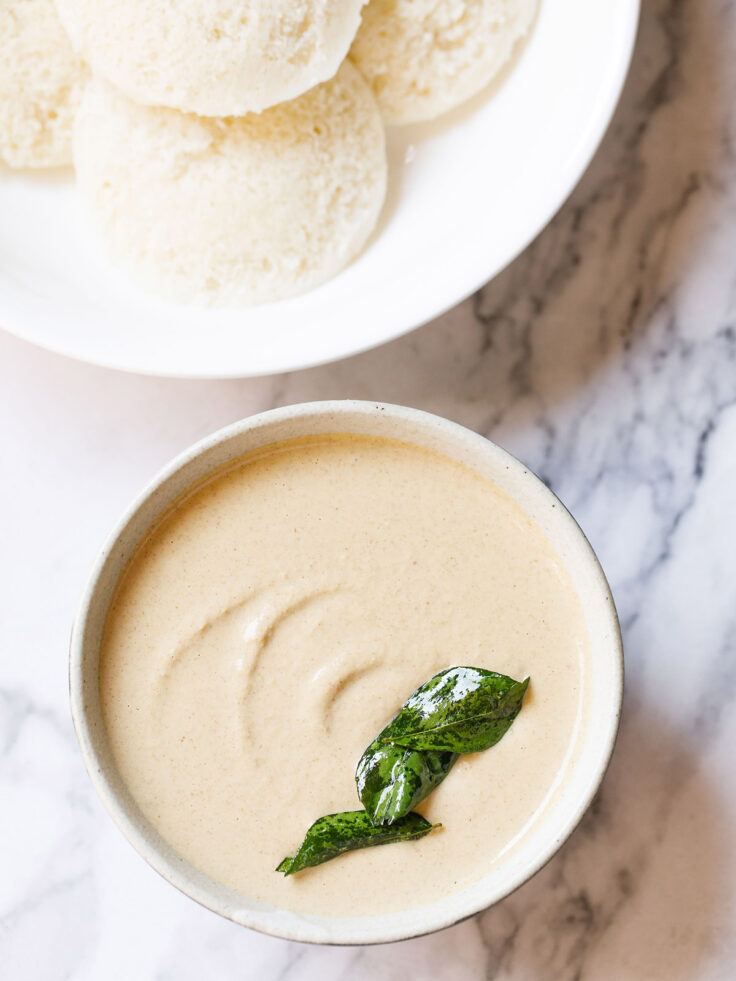
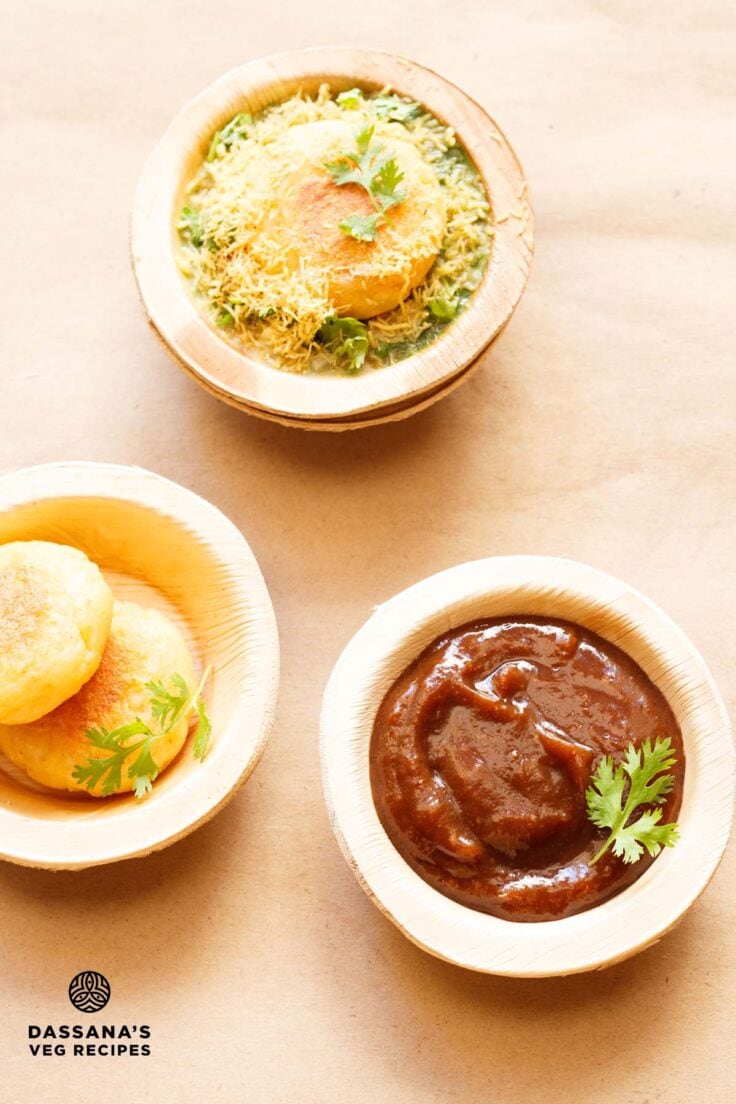
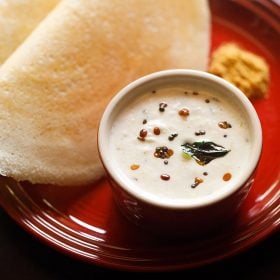
Thanks for sharing Dassana! Excellent recipe. Everyone at home loved it!
Great and thanks so much for letting me know.
Love all your recipes!!
Thanks so much.
This chutney is too good! I can eat 3-4 portions at once.
Yes, us too. Thank you.
Are the chana dal boiled before roasting?
These roasted chana dal are commercially made and easily available online. They are cooked prior to roasting.
Good recipe. Made and liked it.
Good and like my family enjoy that
thanks and nice to know.
Hello,
Could you please let me know what happened with your ‘app’. I had often used it in the past to make so many delicious and wonderful recipes, unfortunately recently I noticed that your app is no longer available. I have been missing it a lot.
I just hope it is only temporary.
Thank you and have a pleasant evening!
Kamal
Welcome Kamal. We had to delete the app because of technical issues.
Good and like the taste of the coconut chutney also my family enjoying that with BANANA BAJJI RECIPE | VAZHAKKAI BAJJI RECIPE thanks and greatful to you
I made this recipe with the desiccated coconut. It was incredibly delicious and I will be making it again! The only differences I found were that I needed to add much more water to the desiccated coconut to make a good paste and I used a little more oil for the spice rendering.
My husband is from the Seychelles and we love indian food! Thank you for so many great recipes.
Welcome Kate. Glad to know this. Thanks for sharing your positive feedback on recipes.
I use frozen grated coconut, that I thaw in the fridge to make this chutney. but I’ve notice that if I grind enough to make a smooth paste, the cream separates from the coconut and the chutney becomes watery. How do I avoid this from happening. If I don’t grind enough the masalas don’t blend, but if I grind till it becomes a smooth paste, it separates. Please help
sanchali, i also use frozen coconut. but i don’t buy frozen coconut from market. i grate coconut with a table top grater. then store the grated coconut in a steel dabba in the freezer. when i want to use, i remove the required amount. i have never faced any issue with the cream separating. always the coconut blends well with the chutney. i do not thaw the coconut. i add it directly in the mixer or grinder jar and grind. so i am not sure why this is happening. may be you can try not thawing the coconut and then grinding it.
I also experienced the same problem several times. Whole character of the chutney alters when the cream separates after grinding. I use the store bought frozen grated coconut. I used to buy fresh coconuts way back but invariably 98% of the time, the whole coconuts are rotten inside. I got tired of this and started buying frozen coconut. I need to investigate why the cream is separating out of coconut.
rom, this happened with me only once when recently when i purchased a pack of frozen grated coconut. usually, i grate coconut and store in the freezer. but for the first time, i used a pack of frozen grated to make chutney and the cream separated. this has only happened with the readymade pack of frozen coconut. when i grate fresh coconut and keep in fridge, this does not happen. i know the chutney consistency, taste completely changes once the cream is separated. it no longer remains a coconut chutney ????. you can even try grinding with warm water. it helps.
Thankyou for demonstrating the recipe step by step. I have tried it is is ????????
Welcome Rawinder
Thanks I have gone through all .still I m always confused ,what means bhuna chana Dal.is it DALIYA WHICH WE GET AT FUTANAWAL,OR SHOUD I TAKE SPLIT CHANA DAL AND FRY IN OIL OR JUST BHUNANA OR USE SOKED CHANA DAL WHICH
TASTES GOOD .I LEAVE ALONE AS FAMILY IS OUT OF STATION.RAJIV
it is the daliya or futana which is roasted chana dal. you can also fry chana dal in oil and then use it. if you use soaked chana dal, then just fry it in some oil and then add while grinding. for daliya or futana, remove the outer brown cover of the chana before adding.
A big , big hit in my family.
Thanks a bunch for the recipe.
🙂
Welcome Bharti
This recipe is a big hit with my husband who is a big fan of South Indian cuisine.
How much ever I thank you, it’s not enough!!
A big bunch of thanks to you.
Xoxo
Welcome Bharti. Thanks for this sweet and positive feedback.
Dear Dassana,
Thank you for many great recipes. I find your site very well organized, and recipies delicious. Living outside India it is difficult to find some ingredients like ChanaDhal though. How would you best substitute them? Roasted chickpeas? Thank uou! Bojana
Welcome Bojana. Thanks for your kind words. Skip the roasted chana dal in this chutney recipe.
Dear Dassana, thank you for sharing yet another wonderful recipe! I have been following your recipes for a long time. I used to be able to copy/paste into a word file collection of your recipes to access in case of internet access failure and to have in front of me while preparing these dishes. I can’t seem to be able to do that any more…has something changed on your site that doesn’t allow this feature any more? It would be most useful to be able to save these awesome recipes for ready reference!
Nandini, i have disabled it because many website owners are copying the content to create their website, app, ebooks.
This is almost identical to the way I make coconut chutney, I also add fresh cilantro (coriander leaves). My tempering ingredients are only rai, sukhi mirch and karyapak. Today I used dried coconut since I didn’t have fresh on hand. It still tastes really good. But if I have a choice I would definitely used fresh grated coconut. Thanks for sharing your recipe.
thanks sana. even i add coriander leaves to coconut chutney at times. fresh coconut is always better, but sometimes one does not have access to fresh coconut, so one can always use dry coconut. welcome sana and happy cooking.
hi can we use store brought grated coconut for chutney’s please reply
jyothi, i have seen some folks using store brought grated coconut. but i never use it. so i cannot say if the chutney made with store brought coconut is good or not.
Thank you so much for this recipe! I have questions about the dals:
Chana Dal: I was planning to soak and roast dry yellow split peas- is that the correct process?
Urad dal- I have dry black split dal that I was planning to soak overnight and use in the recipe. Is that the correct process?
Thank you again for all your helpful recipes! I might have more questions after I attempt the recipe. >.<
1. for chana dal, soak them and then saute them in some oil, till they become nicely golden. then grind with the coconut and other ingredients.
2. for urad dal, no need to soak them. you can add them directly to the tempering. with the black husk on it, the dal still tastes good in the tempering. if you want, you can even saute urad dal in some oil till golden and then grind with the coconut.
sure christine, you can always ask me any queries. happy cooking.
Hi! thank you so much for your beautiful recipes. I am writing from Berlin, Germany and sometimes it is a bit difficult to get the ingredients here. I have a question concerning the spices you use. So far I have never used asofoetida and I checked out some brands here in Germany and it’s never 100% pure hind, but always a spice blend with fenugreek and sometimes even rice or wheat flower. can you give me a tip? that would be much appreciated!
thanks so much and best wishes from Berlin!
thanks alina. hing is also available in small rocks (similar to rock sugar in size) just that it has a dark brown color. this solid hing won’t have any spice blend or wheat flour. this hing is difficult to break also. so you need to roast it well. break in pieces and then grind. grind the these hing pieces in a very good dry grinder and make a powder. you can also use a mortar-pestle to grind to a powder. store and use it as required. most indian brands of hing have wheat flour in it. you can try searching onion for a gluten free hing. you will get some brands.
Made yesterday. Didnt have chana dal -so did with urad dal. Forgot to put red chilli. It was yum. Will be making it more. Thank you for sharing this wonderful recipe. I used desiccated coconut.
thankyou jen for trying the coconut chutney glad to know you liked it.
Excellent recipe.Added green coriander leaves and 1 TBSP of Lemon juice to enhance the taste.
Thanks G Pai for sharing positive feedback and your variation.
Hi Dassana,
I prepared this chutney today alongwith Idli . It was perfect…Thanks aton for this easy and yummy chutney….
I was wondering whether roasted chana dal is added for smooth consistency of the chutney or does it enhance taste also ??..
welcome kallpana. glad to know this. roasted chana dal does enhance the taste.
I made this chutney last night and it was excellent. Would highly recommend it and will trying other recipes on this website.
thanks helen
Hi Dassana, sorry to ask a silly question but just confirming if the red chilli used in the Radha / tempering is fresh OR dry red chilli please .
By the way, I came across your blog only last week whilst looking for gajrela recipes (my fave) and loved the look of your photos and even more than that, I really liked the simple and straightforward way you wrote the step by step directions. needless to say, my first time making gajrela and it came out putrefaction ! A big thank you ! 🙂
welcome bhupinder. thanks for sharing positive feedback. its dry red chillies. no question is silly. feel free to ask any query about recipes.
Thanks a ton. Though I m assamese, l love south Indian dishes specially dosa with coconut chutney. I tried so many recipes of coconut chutney, but couldn’t find the taste I was looking for. Today I tried ur recipe n ….that’s it! Just loved it, so simple n so yummy! Yes, also for d first time I made d best dosa ever, I give this credit to ur wonderful tips in d comment box. I really appreciate not only ur recipes, but also those useful n unique tips u give in d comment box!
welcome sabina. glad to know that you liked the coconut chutney recipe. thanks for sharing your kind words and positive feedback.
Hi, tried this chutney by adding fresh coriander to it. It turned out wonderful.
fresh coriander goes well in this chutney. and thanks for the feedback minakshi.
Added puli(tamarind) to mixture- pure amazing, would recommend u yo add to this recipe.
thanks annamika for your tip.
Thank you. I will try if I can to adopt your reciepts to my taste – no animal proteins and no fry and no kili etc. But only reading, I feel the atmosfere of India. Thank you again!
welcome jenica. you can easily make many indian recipes with vegan substitutes. e.g. for cottage cheese you can use tofu, for dairy yogurt you can use cashew yogurt or soy yogurt. for dairy milk you can use cashew milk, almond milk, coconut milk or soy milk.
Hey, can i use roasted black gram (kala channa) if i cant find bhunna channa daal in local stores?
sadia, yes you can use as an alternative.
Giving best recipes thanks plz give two kgs rice biryani mutton recipe in full details
thanks mahmood. we only add vegetarian recipes.
very nice recipe
thanks saleem
Abs wow!
Hi thank you so much for the lovely easy recipe. Ever since we visited india nd ate the coconut chutney my 10 year old grandson was wanting to eat this cchutney.atlast I got to make it nd it came our finger licking good. Thnk u again nd keep up the great work.
welcome seeniloshinee. felt good after reading your feedback.
The recipe does not specify:
chana dal; raw or cooked?
urad dal; raw or cooked?
jshaski, chana dal is roasted (bhuna hua chana) and urad dal is raw.
Good effort!! How about grinding with curry leaves?
you can grind with curry leaves. just lightly saute the curry in little oil and then grind them with the rest of the ingredients.
Awesome chutnery
thanks jennifer
Coconut Chutney
This is awesome !!
Dear Dassana!
I made idlis and coconut chutney today (both from your site) and it came out just great.
(Even though i did have problems with idli batter, because it’s very cold here in Israel now, and the room temp. is around +17 C. So there was a lack of fermentation problem, and i had to add baking powder…)
The chutney is so easy to make and soooooooo good.
Thank you very much again!
God bless you!
Yana
thanks yana. fermentation just does not happen properly in cold climates. adding baking powder is a good tip. some readers have also told me that they add yeast to make the batter rise in cold climates and the idlis turn out great. coconut chutney is the best accompaniment for idli and dosa.
This is nice recipe but i want another recipe of making coconut chutney without chana dal. and easiest recipe. its my all time favourite chutney. can u pls mail me another recipe.
i will look forward for ur mail.
if you want to make coconut chutney without chana dal, you can easily do so… don’t add the chana dal. coconut chutney can be made without roasted chana dal also. the remaining ingredients can be same as in this recipe…
or just grind coconut with green chilies and temper it with jeera, rai and curry leaves… makes an excellent coconut chutney…
thank u soo much for your recipe.. m jus learning to cook… n i really wanted to make this chutney for the vada.. its jus sooo simple n turned out to be finger-lickin… 🙂
thank you ishaani…. its nice to know that the coconut chutney came out finger-lickin…..